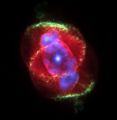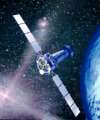



|
Exercise 2 - Edge Detection |

|
This exercise will take you through the process of using an X-ray image to estimate the age of a supernova remnant. The size of the supernova remnant will be estimated both by eye and using edge detection techniques. You can find out more about supernova remnants on this page.
Plotting ProfilesFirst, open the image "CasA_SNR_all.tif" using the Open command in the File menu. The roughly circular object in the centre of the image is the supernova remnant, an expanding shell of high temperature gas. You need to Invert the image (from the Edit menu) so that the object will be shown in black on a pale background. The darkness of each pixel will then depend on the number of photons detected at that point on the camera. You will also need to use the Set Scale option in the Analyze menu to set the Units to "pixels".
To calculate the age of the supernova remnant (SNR), we need to know how large it is. However, the supernova remnant becomes faint around its outer edge, which makes judging its size by eye difficult. We can make a more accurate estimate by taking a profile of the numbers of photons along a line across the SNR. To do this, use the Select Lines tool (fifth from the top on the right hand side of the tools window). You can now draw a line across the supernova remnant, but make sure it extends beyond visible edge of the remnant. When you are satisfied with the line, select Plot Profile from the Analyze menu. A new window will appear with the profile drawn in it. You can expand this window by dragging the frame outwards - place the mouse over the window border to get a double headed arrow, hold down the left mouse buttons, and move the mouse outwards. The plot shows you where the number of detected photons is high and low, and as you move the mouse over the graph the Info window shows the current x and y coordinates you are pointing at. As the x-axis represents position along the line you drew on the image, you can use this to measure the distance in pixels between pints along that line. To measure the width of the supernova remnant, you need to find the point at which the number of photons rises above the background level, and measure the distance to the point at which it drops back down to the background level. The background will be low, probably level with the axis of the plot, so you should be able to see where the supernova remnant begins and ends.

PLOT:- Intensity per pixel along a line passing through the supernova remnant. Note that the intensity drops down to a background level of zero at the edges of the SNR. The sharpest peaks and troughs are caused by problems in processing data from pixels at the edges of CCD chips.
Edge Detection
One problem with using this method is that it is not always clear where the profile drops down to the background level. You may find different answers depending on how large you make your profile plots, as larger plots show more detail. Judgments will also vary between different observers. We can improve on this by using the Find Edges tool in the Process menu. This tool performs a convolution on each pixel - the value of the pixel is changed in a way which depends on the values of the pixels around it. The pixel is covolved with a particular pattern, essentially an equation which calculates the new value of the pixel from its old values and the values of the eight pixels which surround it. In this case, the pattern is chosen so that the convolution alters the image in such a way that pixels whose neighbours have every different values are enhanced, while those whose neighbours are similar to them have their values reduced. The smoothing described in exercise 1 works in the same way, but uses a different pattern. Using the edge detection pattern should mean that regions where the intensity is changing become dark, and flatter areas become pale. Edges, where the pixel intensity changes a great deal in a small number of pixels, will show up as darker regions. You should be able to produce an image like the one shown below.

PLOT:- Zoomed-in view of the SNR after using the Find Edges tool. Dark areas mark regions of rapidly changing intensity (edges) and pale areas show regions of roughly constant intensity. Note the linear features on the image - these are not real, but are produced by problems with processing data near CCD chip boundaries.
With this new image, you can again plot a profile across the supernova remnant. However, in this case the peaks of the profile will mark the positions of edges on the original image. By comparing the image and plot, you should be able to identify which peaks correspond to the outer edges of the SNR. The distance between these peaks is the diameter of the remnant. You should, however, take care to make sure you have the right peaks - the image above shows linear features at the edges of the CCDs, which show up as strong edges but are not part of the SNR. The linear features are made up of pixels whose values do not represent the number of photons actually detected at that position. Various processes can produce these unusually high values in pixels at the edges of CCDs, and it is important to exclude them from your analysis. More information on the CCD chips can be found on the XMM cameras page
Calculating the Age of the Supernova RemnantIn order to get an accurate measurement of the diameter, you will need to make sure the line passes (at least roughly) through the centre of the supernova remnant, and it may be helpful to measure several lines and then take the mean value. You now need to convert this value, measured in pixels, to a more useful format. Each pixel on the detector corresponds to an area on the sky with an angle of 4 arcseconds (1 degree = 60 arcminutes, 1 arcminute = 60 arcseconds). We know that the SNR is approximately 11090 light years away, about 1.05x1020 metres. From this you can work out the radius of the supernova remnant in metres.
It is known that the average amount of energy released in a supernova explosion is 1044 Joules, and that only about one quarter of this goes to push gas outwards. Although the initial explosion throws out the outer layers of the star, most of the gas we see in the remnant is not from the star. As the explosion expands outwards it collects up gas from the interstellar medium, and pushes it forward, building up the shell we see. The amount of gas in the shell is therefore determined by the volume which the remnant has expanded through, and the density of the interstellar medium. On average the density is about 10-21 kg/m3.
The kinetic energy of the shell can be written as
 |
where M is the mass in the shell and V is its velocity. You can calculate the mass in the shell simply, by calculating the volume of a sphere with the radius you have measured from the image, and multiplying this by the density given above. Putting this in the equation, you can rearrange it so as to obtain a value of the expansion velocity of the supernova remnant. You now have the speed at which the supernova remnant is expanding, and the radius it has expanded to, so it it easy to calculate how long this has taken. This should equal the age of the supernova remnant.
The Cassiopeia A supernova remnant is believed to
have been formed by a supernova explosion which was recorded by the
astronomer John Flamsteed in 1680. We therefore know that it is
approximately 320 years old. How does your answer compare to this? If you
have an answer within 100 years of this, you have probably done quite a
good job, as there are other factors which this calculation does not take
into account. For example, the shell of the supernova remnant will not have
expanded in all directions evenly, and it is likely to have been slowed
down to some extent as it expands and picks up more gas. These effects (and
others) will make your answer less accurate.
SUMMARY
In this exercise you have learned about the following:
- Measuring the sizes of astronomical objects
- The use of edge detection techniques to improve measurement accuracy
- Estimating the age of supernova remnants based on their current size

